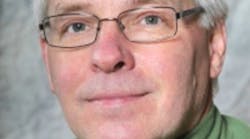Boston MA. “Biomedical innovation, a report from the frontier,” was the title of a keynote address delivered April 18 at BIOMEDevice, co-located with ESC Boston. Jeff Karp, Professor of Medicine at Brigham and Women’s Hospital, recounted operating at the intersection medicine and science to develop tools for accelerated medical innovation.
Karp began by warning that—should you at fail on your first try—you should avoid a second try involving more of the same. He provided by way of example an effort to use a crane to retrieve a submerged vehicle in Ireland back in 2004. Rather than hauling the car out of the water, the crane plunged in. In a more-of-the-same approach, a second, larger crane was brought in to retrieve the first crane and the car, and it reportedly fell into the water as well.
You can see the sequence of photos here, and Snopes notes the photo of the second crane falling into the water was faked. Nevertheless, Karp’s point stands. If the second crane’s was successful, it’s because someone likely did some calculations involving weights and moments to ensure success—not because operators simply repeated the failed first effort on a larger scale.
Karp’s research involves not retrieving submerged automobiles but rather what he calls a bioinspired approach for next-generation regenerative medicine. He cited work with Dr. Pedro del Nido of Boston Children’s Hospital on treatments for children with perforations between their heart chambers. For children, medical implants of fixed size are less than ideal because they can’t accommodate normal tissue growth, leading to requirements for repeated interventions.
The researchers wanted to develop a patch onto which growing tissue cells would migrate, with the patch eventually biodegrading. Yet the patch would need to withstand the very harsh environment of a beating heart. They turned to bioinspiration for a solution. Every living creature alive today has overcome nearly insurmountable odds to avoid extinction, Karp said. Life represents hundreds of millions of years of R&D, with new chapters constantly being written.
The researchers looked for their inspiration to sandcastle worms, slugs, and snails, all of which produce viscous secretions not easily washed away. This insight led to the development of a hydrophobic, light-cured adhesive patch material that can close ventricular wall defects without sutures—just glue. The researchers have experimented with the technique on rats and pig models, as described in a paper on the research.
The technique also holds potential for nerve reconstruction, Karp said, adding that the material can be 3D-printed, offering a new paradigm for biomedical implants. He also recounted giving a talk on the technique at the Boston Aquarium, where his talk was nearly drowned out by the penguins, who seem not to enjoy competition for attention. Fortunately, William Rosenblad, a veterinary dental surgeon at the MSPCA Angell Animal Medical Center, heard enough of the talk that he was able to apply the adhesive to repair an oronasal fistula in “Little Papi,” a 10-year-old bulldog named after Boston Red Sox legend David “Big Papi” Ortiz, as reported in The Boston Globe.
Karp cited other research as well, including work on drug delivery to treat arthritis. He noted the benefits of time-release medications but also the drawbacks—they are released system-wide continuously, even during periods of remission, potentially exposing patients to unnecessary levels of toxicity. To overcome the drawbacks, Karp and fellow researchers developed an inflammation-targeting hydrogel that delivers medication when—and where—it’s needed. The work was published April 3 in Nature Communications; The Harvard Gazette provides an overview.
Karp noted that in an effort to improve their chances of getting published in journals, researchers often tend to try to make their papers as complicated as possible. But that’s not serving your patients, he said, advising that simplicity is important. In addition to bioinspiration, he concluded, another tool in your toolbox should be “radical simplicity.” In the development of the drug-delivery system, for example, he said the researchers asked whether they could use really simple components, ones on the GRAS (generally recognized as safe) list. For radical simplicity, he said, consider your spectrum of options and aim for simple at all steps.

